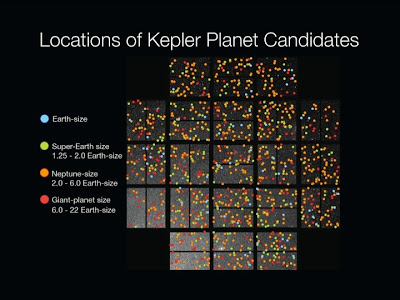NASA press release on the 1202 new Kepler telescope exoplanets. NASA Kepler telescope found 1202 exoplanet candidates in 1/400th of the sky. The numbers extrapolated to some 20,000 habitable-zone planets within 3,000 light-years of Earth.
Exoplanets classified by size which are:
- 68 Earth-size exoplanets with a radius (Rp) of less than 1.25 Earth radius (Re) - 288 super-Earth size exoplanets with 1.25 x Re < Rp ≤ 2.0 x Re - 662 Neptune-size exoplanets with 2.0 x Re < Rp ≤ 6.0 x Re - 165 Jupiter-size exoplanets with 6.0 x Re < Rp ≤ 15 x Re - 19 very-large-size with 15.0 x Re < Rp ≤ 22 x Re
The Feb 2, 2011 pictures and videos from NASA are at this link
NASA’s Kepler mission news page
“We went from zero to 68 Earth-sized planet candidates and zero to 54 candidates in the habitable zone – a region where liquid water could exist on a planet’s surface. Some candidates could even have moons with liquid water,” said William Borucki of NASA’s Ames Research Center, Moffett Field, Calif., and the Kepler Mission’s science principal investigator. “Five of the planetary candidates are both near Earth-size and orbit in the habitable zone of their parent stars.”
Kepler will continue conducting science operations until at least November 2012, searching for planets as small as Earth, including those that orbit stars in a warm habitable zone where liquid water could exist on the surface of the planet. Since transits of planets in the habitable zone of solar-like stars occur about once a year and require three transits for verification, it is expected to take three years to locate and verify Earth-size planets orbiting sun-like stars.
Borucki predicted that the search using the Kepler spacecraft’s continuous and long-duration capability will significantly enhance scientists’ ability to determine the distributions of planet size and orbital period in the future.
“In the coming years, Kepler’s capabilities will allow us to find Earth-size planets in the habitable zone of other stars,” Borucki said. “Future missions will be developed to study the composition of planetary atmospheres to determine if they are compatible with the presence of life. The design for these missions depends of Kepler finding whether Earth-size planets in the habitable zone are common or rare.”
If you liked this article, please give it a quick review on ycombinator or StumbleUpon. Thanks

Brian Wang is a Futurist Thought Leader and a popular Science blogger with 1 million readers per month. His blog Nextbigfuture.com is ranked #1 Science News Blog. It covers many disruptive technology and trends including Space, Robotics, Artificial Intelligence, Medicine, Anti-aging Biotechnology, and Nanotechnology.
Known for identifying cutting edge technologies, he is currently a Co-Founder of a startup and fundraiser for high potential early-stage companies. He is the Head of Research for Allocations for deep technology investments and an Angel Investor at Space Angels.
A frequent speaker at corporations, he has been a TEDx speaker, a Singularity University speaker and guest at numerous interviews for radio and podcasts. He is open to public speaking and advising engagements.







